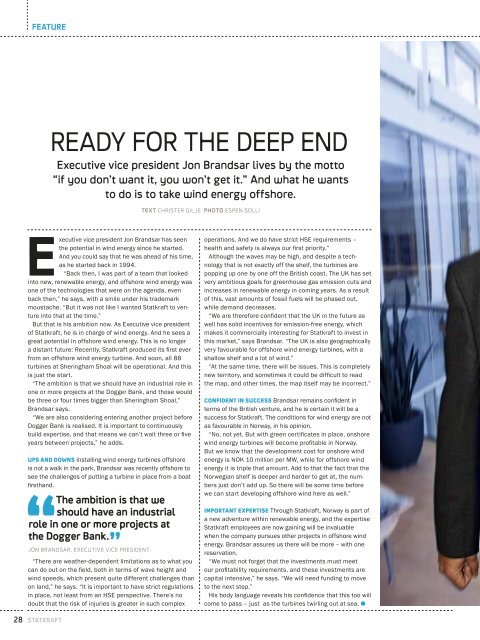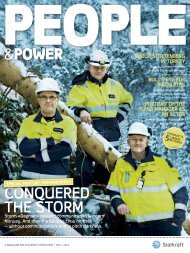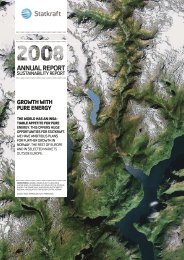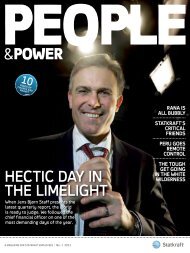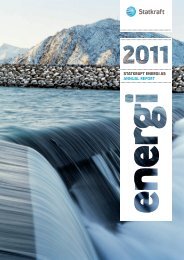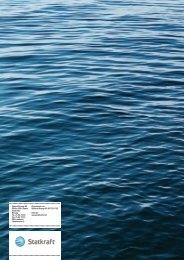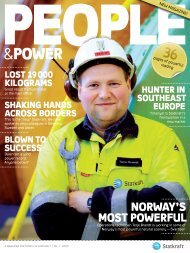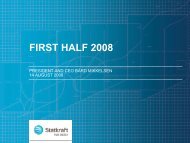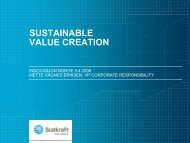Create successful ePaper yourself
Turn your PDF publications into a flip-book with our unique Google optimized e-Paper software.
Fe<strong>AT</strong>Ure<br />
executive vice president Jon Brandsar has seen<br />
the potential in wind energy since he started.<br />
And you could say that he was ahead of his time,<br />
as he started back in 1994.<br />
“Back then, Iwas part of ateam that looked<br />
into new, renewable energy,and offshore wind energy was<br />
one ofthe technologies that were on the agenda, even<br />
back then,” he says, with asmile under his trademark<br />
moustache. “But itwas not like Iwanted <strong>Statkraft</strong> to venture<br />
into that at the time.”<br />
But that is his ambition now. As Executive vice president<br />
of <strong>Statkraft</strong>, he is in charge of wind energy.And he sees a<br />
great potential in offshore wind energy.This isnolonger<br />
adistant future: Recently, <strong>Statkraft</strong> produced its first ever<br />
from an offshore wind energy turbine. And soon, all 88<br />
turbines at Sheringham Shoal will be operational. And this<br />
is just the start.<br />
“The ambition is that we should have an industrial role in<br />
one ormore projects atthe Dogger Bank, and those would<br />
be three orfour times bigger than Sheringham Shoal,”<br />
Brandsar says.<br />
“We are also considering entering another project before<br />
Dogger Bank is realised. Itisimportant to continuously<br />
build expertise, and that means wecan’t wait three orfive<br />
years between projects,” he adds.<br />
ups anDDoWns Installing wind energy turbines offshore<br />
is not a walk in the park, Brandsar was recently offshore to<br />
see the challenges of putting a turbine in place from a boat<br />
firsthand.<br />
“There are weather-dependent limitations astowhat you<br />
can doout on the field, both in terms of wave height and<br />
wind speeds, which present quite different challenges than<br />
on land,” he says. “It is important tohave strict regulations<br />
in place, not least from anHSE perspective. There’s no<br />
doubt that the risk ofinjuries isgreater insuch complex<br />
28 StatKraft<br />
readyFor thedeepend<br />
Executive vice president Jon Brandsar lives by the motto<br />
“if you don’t want it, you won’t get it.” and what he wants<br />
to do is to take wind energy offshore.<br />
Theambitionisthatwe<br />
should have an industrial<br />
role in oneormoreprojectsat<br />
theDoggerBank.<br />
Jon Brandsar, exeCUtive viCe president<br />
TexT Christer giLJe PHOTO espen soLLi<br />
operations. And wedohave strict HSE requirements –<br />
health and safety isalways our first priority.”<br />
Although the waves may behigh, and despite atechnology<br />
that is not exactly off the shelf, the turbines are<br />
popping up one byone off the British coast. The UKhas set<br />
very ambitious goals for greenhouse gas emission cuts and<br />
increases inrenewable energy in coming years. As aresult<br />
of this, vast amounts offossil fuels will bephased out,<br />
while demand decreases.<br />
“We are therefore confident that the UKinthe future as<br />
well has solid incentives for emission-free energy,which<br />
makes itcommercially interesting for <strong>Statkraft</strong> to invest in<br />
this market,” says Brandsar. “The UKisalso geographically<br />
very favourable for offshore wind energy turbines, with a<br />
shallow shelf and alot of wind.”<br />
“At the same time, there will beissues. This is completely<br />
new territory, and sometimes itcould be difficult to read<br />
the map, and other times, the map itself may beincorrect.”<br />
confiDent in success Brandsar remains confident in<br />
terms of the British venture, and he is certain it will be a<br />
success for <strong>Statkraft</strong>. The conditions for wind energy are not<br />
as favourable in Norway, in his opinion.<br />
“No, not yet. But with green certificates inplace, onshore<br />
wind energy turbines will become profitable in Norway.<br />
But weknow that the development cost for onshore wind<br />
energy is NOK 10million per MW, while for offshore wind<br />
energy it is triple that amount. Add to that the fact that the<br />
Norwegian shelf is deeper and harder to get at, the numbers<br />
just don’t add up. So there will besome time before<br />
we can start developing offshore wind here aswell.”<br />
important expertise Through <strong>Statkraft</strong>, Norway is part of<br />
a new adventure within renewable energy, and the expertise<br />
<strong>Statkraft</strong> employees are now gaining will be invaluable<br />
when the company pursues other projects in offshore wind<br />
energy. Brandsar assures us there will be more – with one<br />
reservation.<br />
“We must not forget that the investments must meet<br />
our profitability requirements, and these investments are<br />
capital intensive,” he says. “We will need funding to move<br />
to the next step.”<br />
His body language reveals his confidence that this too will<br />
come to pass –just asthe turbines twirling out atsea.<br />
Executive vice president Jon Brandsar<br />
has seen the potential inoffshore<br />
wind energy since 1994. Heisnow<br />
finally able togoall in.<br />
OFFSHOre wIND eNerGy<br />
theBritish<br />
want More wind<br />
theirsaiLs<br />
the 2009 eureneWables Directive<br />
requires the average share of renewables to<br />
increase from 8.5 to20per cent. The UK goal is<br />
15 per cent, up from amore modest three per<br />
cent. Offshore wind energy will play akey role in<br />
achieving this goal.<br />
“We have some ofthe best wind resources in<br />
the world, and it would bemadness not totry to<br />
exploit these better,” says aspokesperson from<br />
the British Ministry ofEnergy.<br />
The recently published document “UK<br />
Renewable Energy Roadmap” determines that the<br />
UK will strengthen its position as the world leader<br />
within offshore wind energy.The total installed<br />
capacity will increase from the current 1.3 GW to<br />
18 GW by 2020. But it will be demanding.<br />
“Realising this potential will require asignificant<br />
cost reduction,” says the roadmap document. “It<br />
will necessitate actions beyond what has already<br />
been planned.” The document goes ontolist<br />
measures that will ensure the industry becomes<br />
viable, without putting too much strain on the<br />
wallets ofthe consumers. One priority area isthe<br />
supply industry.<br />
“We focus on what the British government can<br />
influence, such as developing production facilities<br />
in existing ports, “adds the ministry spokesperson.<br />
“We are allocating GBP 60 million towards<br />
this until 2015. The funds are meant to encourage<br />
private investments in necessary facilities.”<br />
But the British also depend on international<br />
companies.<br />
“We will need major investments inour entire<br />
energy infrastructure. Distribution and production<br />
alone will require GBP 110 million,” the spokesperson<br />
says.<br />
we have some of the<br />
best wind resources<br />
in theworld,and it would<br />
be madnessnot to tryto<br />
exploitthese better.<br />
PEoPlE & PowEr<br />
29


